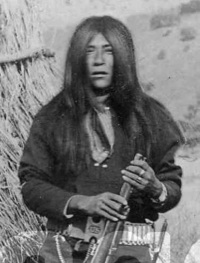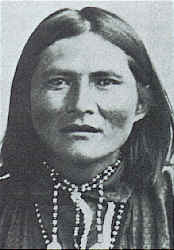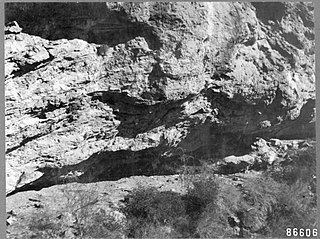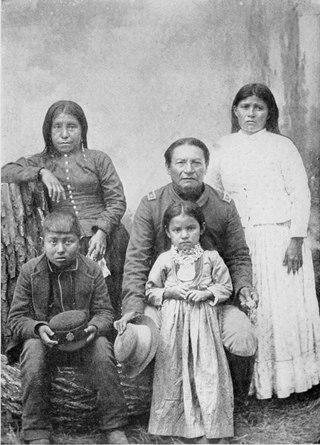
Chiricahua is a band of Apache Native Americans.

Gerónimo was a military leader and medicine man from the Bedonkohe band of the Ndendahe Apache people. From 1850 to 1886, Geronimo joined with members of three other Central Apache bands – the Tchihende, the Tsokanende and the Nednhi – to carry out numerous raids, as well as fight against Mexican and U.S. military campaigns in the northern Mexico states of Chihuahua and Sonora and in the southwestern American territories of New Mexico and Arizona.

The Apache Wars were a series of armed conflicts between the United States Army and various Apache tribal confederations fought in the southwest between 1849 and 1886, though minor hostilities continued until as late as 1924. After the Mexican–American War in 1846, the United States annexed conflicted territory from Mexico which was the home of both settlers and Apache tribes. Conflicts continued as American settlers came into traditional Apache lands to raise livestock and crops and to mine minerals.

Massai was a member of the Mimbres/Mimbreños local group of the Chihenne band of the Chiricahua Apache. He was a warrior who was captured but escaped from a train that was sending the scouts and renegades to Florida to be held with Geronimo and Chihuahua.

Emmet Crawford was an American soldier who rose through the ranks to become an officer. He was most noted for his time spent in the Arizona Territory under General George Crook in the United States Cavalry. He was killed in pursuit of the Apache leader Geronimo in January 1886 in Mexico.

The Apache Scouts were part of the United States Army Indian Scouts. Most of their service was during the Apache Wars, between 1849 and 1886, though the last scout retired in 1947. The Apache scouts were the eyes and ears of the United States military and sometimes the cultural translators for the various Apache bands and the Americans. Apache scouts also served in the Navajo War, the Yavapai War, the Mexican Border War and they saw stateside duty during World War II. There has been a great deal written about Apache scouts, both as part of United States Army reports from the field and more colorful accounts written after the events by non-Apaches in newspapers and books. Men such as Al Sieber and Tom Horn were sometimes the commanding officers of small groups of Apache Scouts. As was the custom in the United States military, scouts were generally enlisted with Anglo nicknames or single names. Many Apache Scouts received citations for bravery.

Al Sieber was a German-American immigrant who fought in the American Civil War (1861-1865), and in the American Old West frontier against the Native Americans. (Indians) in the later American Indian Wars of the mid to late 19th century. He became a prospector and later served as a decorated Chief of Scouts for the United States Army dring the subsequent Apache Wars of 1849 - 1886 in the southwestern United States.

Kas-tziden or Haškɛnadɨltla, more widely known by his Mexican-Spanish appellation Nana, was a warrior and chief of the Chihenne band of the Chiricahua Apache. A trusted lieutenant to Cuchillo Negro and Mangas Coloradas, in the 1850s and 1860s he was one of the best known leaders of the Chihenne (Tchiende), along with Tudeevia, Ponce and Loco. He was a nephew of Delgadito, and married a sister of Geronimo.

Alchesay, also known as William Alchesay, Alchisay and Alchise, was a chief of the White Mountain Apache tribe and an Indian Scout. He received the United States military's highest decoration for bravery, the Medal of Honor, for his actions during the Indian Wars.

Camillus "Buck" Sydney Fly was an Old West photographer who is regarded by some as an early photojournalist and who captured the only known images of Native Americans while they were still at war with the United States. He took many other pictures of life in the silver-mining boom town of Tombstone, Arizona, and the surrounding region. He recognized the value of his photographs to illustrate periodicals of the day and took his camera to the scenes of important events where he recorded them and resold pictures to editors nationwide.

First Lieutenant Charles Bare Gatewood was an American soldier born in Woodstock, Virginia. He was raised in Harrisonburg, Virginia, where his father ran a press. He served in the United States Army in the 6th Cavalry after graduating from West Point. Upon assignment to the American Southwest, Gatewood led platoons of Apache and Navajo scouts against renegades during the Apache Wars. In 1886, he played a key role in ending the Geronimo Campaign by persuading Geronimo to surrender to the army. Beset with health problems due to exposure in the Southwest and Dakotas, Gatewood was critically injured in the Johnson County War and retired from the Army in 1895, dying a year later from stomach cancer. Before his retirement he was nominated for the Medal of Honor, but was denied the award. He was portrayed by Jason Patric in the 1993 film Geronimo: An American Legend.

The Yavapai Wars, or the Tonto Wars, were a series of armed conflicts between the Yavapai and Tonto tribes against the United States in the Arizona Territory. The period began no later than 1861, with the arrival of American settlers on Yavapai and Tonto land. At the time, the Yavapai were considered a band of the Western Apache people due to their close relationship with tribes such as the Tonto and Pinal. The war culminated with the Yavapai's removal from the Camp Verde Reservation to San Carlos on February 27, 1875, an event now known as Exodus Day.

The raid on Bear Valley was an armed conflict that occurred in 1886 during Geronimo's War. In late April, a band of Chiricahua Apaches attacked settlements in Santa Cruz County, Arizona over the course of two days. The Apaches raided four cattle ranches in or around Bear Valley, leaving four settlers dead, including a woman and her baby. They also captured a young girl, who was found dead several days after the event, and stole or destroyed a large amount of private property. When the United States Army learned of the attack, an expedition was launched to pursue the hostiles. In May, two small skirmishes were fought just across the international border in Sonora, Mexico but both times the Apaches were able to escape capture.

The Apache Campaign of 1896 was the final United States Army operation against Apaches who were raiding and not living in a reservation. It began in April after Apache raiders killed three white American settlers in the Arizona Territory. The Apaches were pursued by the army, which caught up with them in the Four Corners region of Arizona, New Mexico, Sonora and Chihuahua. There were only two important encounters during the campaign and, because both of them occurred in the remote Four Corners region, it is unknown if they took place on American or Mexican soil.

Chato was a Chiricahua Apache subchief who carried out several raids on settlers in Arizona in the 1870s. His Apache name was Bidayajislnl or Pedes-klinje. He was a protege of Cochise, and he surrendered with Cochise in 1872 going to live on the San Carlos Reservation in southern Arizona, where he became an Apache Scout. Following his service as a scout he was taken prisoner after being coerced to travel to Washington, D.C. Chato was imprisoned in St. Augustine, Florida along with almost 500 other Apache at Fort Marion.

Tso-ay, also known as Panayotishn or Pe-nel-tishn, today widely known by his nickname as "Peaches", was a Chiricahua, Western Apache warrior, who also served as a scout for General George Crook during the Apache Wars. Tso-ay was wounded while fighting alongside Geronimo and Chihuahua against Mexican troops, who had ambushed them after the Apache had crossed the border while being pursued by American troops.
Ulzana, was a Tsokanende Apache war chief, brother of Chihuahua.
First Lieutenant Britton Davis was an American soldier born in Brownsville, Texas. He served in the United States Army in the 6th Cavalry after graduating from West Point in 1881. After serving at Fort D.A. Russell, Davis was transferred to the Southwest to serve at San Carlos in 1882 during the Apache Wars where he commanded two companies of Apache Scouts alongside Captain Emmet Crawford. In 1886, he played a key role in ending the Geronimo Campaign.

Chihuahua or Chewawa,, was chief of the Chokonen local group of the Tsokanende Band of Chiricahua Apache who carried out several raids on settlers in Arizona in the 1870s and 1880s. His elder brother Ulzana, who would later become known as leader of a very famous raid through New Mexico and Arizona in 1885, was his war chief (segundo). Chihuahua's name in the Mescalero-Chiricahua language was Kla-esh or Tłá'í'ez.

The Geronimo Surrender Site is situated above Skeleton Canyon in southeastern Arizona, on a small bluff. Overlooking the canyon, the San Bernardino Valley and San Simon Valley can be seen to the east and west. The actual site is marked by a cairn of rocks, which was erected by Lieutenant Henry W. Lawton, on the spot where Geronimo surrendered to General Nelson A. Miles in 1886.


















